Lawn Issues
There are around 30 different species of moss found in UK lawns. They tend to infect lawns when the grass surface is sparse although living in the UK, with its damp conditions moss will be found in most lawns during the cooler months.
Moss spores are produced in spring and autumn when infect lawns, sometimes we even help spread them by raking the lawns surface.
Any practice that reduces the thickness of the lawn will aid the development of moss i.e. mowing too short, compaction, poor drainage and the creation of shade. So to reduce moss raise the height of your lawn mower and aerate regularly.
Moss can be killed and even in severe infestations the area can be claimed back to lawn.
We will be happy to advise you on a suitable program for your lawn.
Fusarium Patch
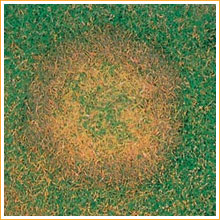 The most common UK lawn disease, caused by the fungus, microdochium nivale.
The most common UK lawn disease, caused by the fungus, microdochium nivale.
Cool and wet conditions are favoured by this fungus and also grasses which are weak as a result of lack of nutrition. All UK grasses can succumb to fusarium patch but the disease is normally seen first in Poa annua due to its shallow rooting. Initial infections are small but these can rapidly enlarge.
The disease can be recognised by the white or pink gossamer like mycelium on the leaf surface.
Control
Fusarium can be controlled by the application of an appropriate fungicide.
If you would like further details please contact us.
![]()
Red Thread
 Red thread infection can occur on all lawn grasses but is particularly common on ryegrasses and fescues.
Red thread infection can occur on all lawn grasses but is particularly common on ryegrasses and fescues.
Mild, damp weather is favoured by this fungus, Laetisaria fucifrormis. Red Thread used to be prevalent on under fertilised lawns but recently we have noticed this fungal disease even on well fertilised lawns.
Red Thread is quite easy to identify by the red shards that grow outwards from the leaf.
Control
Red thread can be controlled by the application of an appropriate fungicide; scarification and aeration will reduce the thatch layer and improve water penetration.
If you would like further details please contact us.
![]()
Dry Patch
 This phenomenon occurs in the root zone of the lawn, the material making up the root zone becomes hydrophobic or water repellent.
This phenomenon occurs in the root zone of the lawn, the material making up the root zone becomes hydrophobic or water repellent.
Dry patch normally occurs during the summer and early autumn, it can be prevent or the symptoms controlled.
Control
Dry Patch can be controlled by the application of an appropriate surfactant; Aeration will also improve water penetration.
If you would like further details please contact us.
![]()
Anthracnose
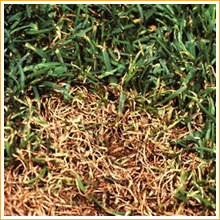 In the UK anthracnose only attacks Poa Annua it is caused by the fungus Colletotrichum graminicola.
In the UK anthracnose only attacks Poa Annua it is caused by the fungus Colletotrichum graminicola.
Periods of cool, wet weather are favoured by this fungus and also grasses which are weak as a result of low fertility or over compacted root zones.
Control
Anthracnose can be controlled by the application of an appropriate fungicide.
If you would like further details please contact us.
![]()
Rust
 Rust can attack all UK lawn grasses, but is particularly attracted to perennial ryegrass and Poa pratensis.
Rust can attack all UK lawn grasses, but is particularly attracted to perennial ryegrass and Poa pratensis.
It can occur throughout the year but is normally seen during early summer to late autumn during mild humid weather.
Rust is easy to identify. The affected grass appears rust coloured due to the spores present on the leaf.
Control
Rust can be controlled by aeration, and depending on the conditions, a light application of fertiliser.
Increasing your mowing height and frequency will also aid recovery.
If you would like further details please contact us.
![]()
Dollar spot
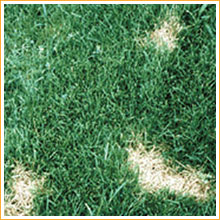 Dollar spot generally attacks the finer grasses and in particular varieties of red fescue.
Dollar spot generally attacks the finer grasses and in particular varieties of red fescue.
Mid-spring to early autumn are the times you will mostly see it often after extended periods of leaf wetness occurring during warm days and cool nights
The main symptoms are numerous small bleached spots.
Control
Dollar spot can be controlled by the application of an appropriate fungicide and aeration.
If you would like further details please contact us.
Whatever your lawn disease, we can apply curative or preventative products to keep your lawn looking good.
![]()
Fairy rings normally occur in poor light soils or quite often in area where tree stumps have been cut down below the lawn surface and left in the soil to rot. Fungi form in the soil and develop threads that pack together very closely and eventually starve the grass roots of both water and nutrients. The effect of the lawn can vary and conventionally fairy rings are grouped into three classes depending on the severity of the infection.
 Class 1
Class 1
The most severe, a dry, dying ring forms in the lawn, sandwiched between two dark rings. The dying ring sometimes contains white fluffy deposits which are mycelium; this white substance will also be seen in the soil if lightly excavated.
The two outer rings look dark and healthy this is due to the release of nitrogen as a result of the causal fungi decomposing the organic matter within the soil.
 Class 2
Class 2
Similar to class 1 but without the dying area in between the two dark rings. A single ring or part of the ring, forming an arc, is created.
This is the most common class found in UK lawns.
 Class 3
Class 3
Rings or arcs of fruiting bodies such as mushrooms or toadstools. Normally no damage is caused to the grass.
Depending on the severity of the fairy ring, chemical, cultural or both types of treatment may be required. We will be happy to advise what treatments are appropriate for your lawn.
If you would like further details please contact us
![]()
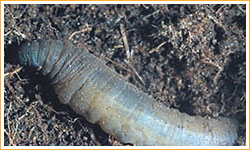 Leatherjackets
Leatherjackets
The recent warm winters have seen an explosive expansion of the Crane fly “Daddy Long legs”. They can be seen in September in grassed areas looking for sites to lay their eggs.
Over the winter months the eggs hatch and the resultant larvae, leatherjackets, literally start to eat through the root system of the lawn causing devastating 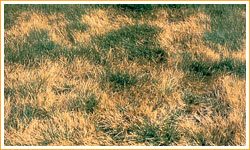 results. It is not uncommon to see examples of domestic lawns totally obliterated as a result of leatherjacket attack. Damage can be seen from January through to April.
results. It is not uncommon to see examples of domestic lawns totally obliterated as a result of leatherjacket attack. Damage can be seen from January through to April.
We can provide treatments to protect lawns against potential attack or can assist in repairing lawns that have been attacked and may seem hopeless.
![]()
Chafer Grubs
 The garden chafer is the larval stage of the May Bug; they normally cause most damage to lawns in August and September in a similar way to the leatherjacket they feed off the plant roots. Normally healthy turf can suddenly wilt and die.
The garden chafer is the larval stage of the May Bug; they normally cause most damage to lawns in August and September in a similar way to the leatherjacket they feed off the plant roots. Normally healthy turf can suddenly wilt and die.
We can provide treatments to protect lawns against potential attack or can assist in repairing lawns that have been attacked and may seem hopeless.
In both leatherjacket and Chafer grub attacks quite often the first signs of trouble are birds digging in the lawn to feed on the pests.
If you would like further details please contact us.
![]()
Worms
 Worms are great for soil. They create large channels that encourage gas exchange and allow water and nutrients to penetrate deep into the soil. They also act as a little aerator benefitting the soil structure and they actually help to decompose thatch.
Worms are great for soil. They create large channels that encourage gas exchange and allow water and nutrients to penetrate deep into the soil. They also act as a little aerator benefitting the soil structure and they actually help to decompose thatch.
However they do cause problems when they surface, normally in the wetter winter months, they produce casts, which are little heaps of soil that have passed through the worm. These casts tend to smear on the lawns surface covering the grass beneath them and creating idea seeding ground for weeds and moss.
We can provide treatments which will not kill the worms but will encourage them to remain in the soil and carry on doing their good work.
If you would like further details please contact us.
![]()
Ants
 Ants can be a major irritant on lawns during the spring and summer. They don’t cause problems in themselves but their home building can leave bumps on the lawn which when squashed as a result of mowing leave large soil caps on the surface.
Ants can be a major irritant on lawns during the spring and summer. They don’t cause problems in themselves but their home building can leave bumps on the lawn which when squashed as a result of mowing leave large soil caps on the surface.
The only effective product on the market is nematodes, microscopic, parasitic worms which are watered onto the ants nest.
If you would like further details please contact us.
![]()
 Algae
Algae
During wet weather an area of exposed soil within a lawn may develop Algae which looks like a green or blackish scum like covering. Algae on a lawn are a symptom of poor drainage, or compacted soil.
Hollow tine aeration is recommended to reduce the compaction.
![]()
 Lichens
Lichens
Lichens found on UK lawns are normally greenish-black or greyish leaf-like structures that grow horizontally in the turf. Similar to Algae, lichens are symptoms of poorly drained soil, compacted soil.
Hollow tine aeration is recommended to reduce the compaction.
If you would like further details please contact us.


















